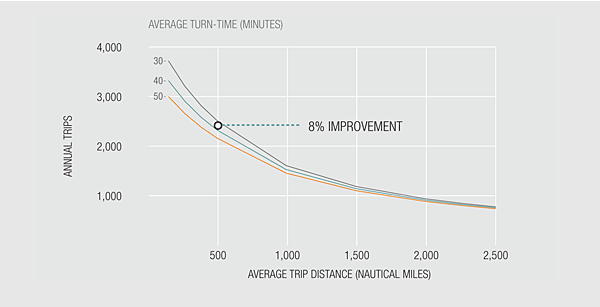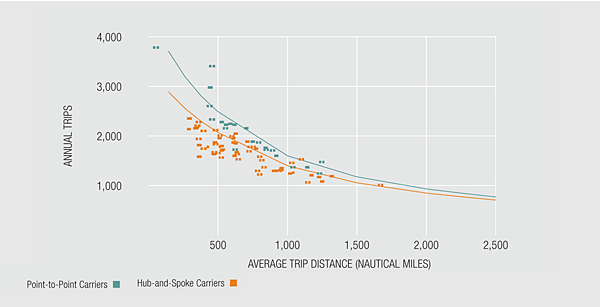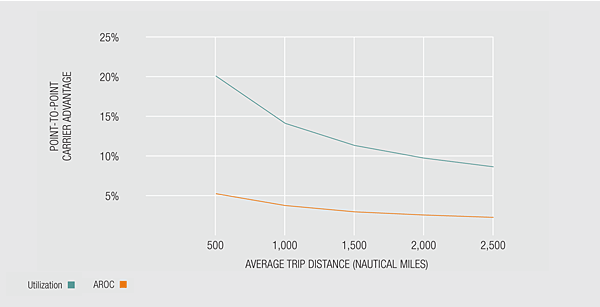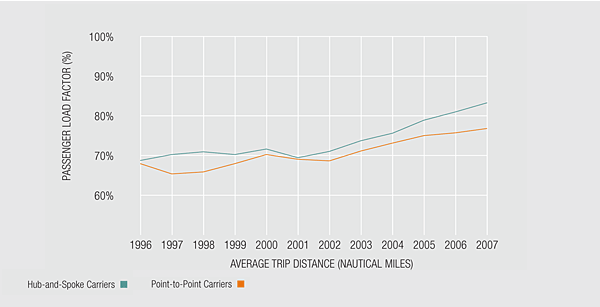
REAL-WORLD APPLICATIONS OF AIRPLANE UTILIZATION
Airplane utilization and turn-time models provide useful information for schedule planning, fleet planning, operations planning, and economic and financial analysis. For example, using the utilization/turn-time model for a point-to-point carrier with an average turn-time of 40 minutes gives an estimated utilization level of 2,304 trips per year with an average mission length of 500 nautical miles. Reducing the average turn-time by just 10 minutes — from 40 to 30 minutes — improves the utilization level to 2,491 trips per year, an increase of 8.1 percent (see fig. 3). This efficiency can enable a carrier to reduce the number of airplanes it needs to have in its fleet to make an equal number of trips.
EFFECTS OF TURN-TIME REDUCTIONS ON AIRPLANE UTILIZATION
Figure 3
Reducing turn-time by 10 minutes with an average trip length of 500 nautical miles improves airplane utilization by 8 percent.

With increased average trip distance, airplane utilization in terms of flight hours increases but number of trips per year decreases, reducing the potential savings from shorter turn-times. Because of their average trip distances, point-to-point carriers can achieve greater airplane utilization than hub-and-spoke carriers (see fig. 4). The advantage is quite significant at around 20 percent for shorter mission lengths (approximately 500 miles) and reduces to about 10 percent for longer mission lengths (approximately 2,000 miles).
AIRPLANE UTILIZATION PROFILE
Figure 4
Point-to-point carriers have a significant advantage in airplane utilization compared to carriers operating on a typical hub-and-spoke system.

This increased utilization allows operators to distribute fixed ownership costs over higher number of trips, effectively lowering airplane-related operating costs (AROC) compared to hub-and-spoke carriers. Increasing airplane utilization by 20 percent effectively lowers AROC by about 5 percent, a significant reduction. As mission lengths increase, this advantage decreases (see fig. 5). In fact, the hub-and-spoke model, which requires relatively longer turn-times, offsets the disadvantage of lower airplane utilization by capturing higher load factors (see fig. 6).
AROC ADVANTAGE OF IMPROVED AIRPLANE UTILIZATION
Figure 5
The greater airplane utilization that point-to-point carriers can achieve relative to hub-and-spoke carriers allows them to distribute fixed ownership costs over more trips, effectively lowering AROC. Increasing airplane utilization by 20 percent has the effect of lowering AROC by about 5 percent. As mission lengths increase, this advantage decreases due to fewer opportunities to save time at the gate.

PASSENGER LOAD FACTORS FOR HUB-AND-SPOKE AND POINT-TO-POINT CARRIERS
Figure 6
Although they have longer turn-times, hub-and-spoke carriers tend to have higher passenger load factors.

HOW OPERATORS CAN INCREASE AIRPLANE UTILIZATION
Operators who would like to take advantage of the cost savings and efficiencies of increased airplane utilization may want to start by educating their workforces about the positive effects of reducing turn-times. For example, the airline may explain that saving 10 minutes on 2,000 trips per year means an additional 20,000 minutes — or more than 300 hours — available for additional flights. More flights mean more paying passengers and, ultimately, more revenue.
SUMMARY
Reducing airplane turn-times means more efficient airplane utilization, particularly for airlines that emphasize point-to-point routes. Benefits of shorter turn-times are significant for shorter average trip distances. For example, a 10-minute faster average turn-time can increase airplane utilization by 8 percent and lower AROC for a typical single-aisle airplane by 2 percent.
For more information, please contact Mansoor Mirza at mansoor.mirza@boeing.com.

